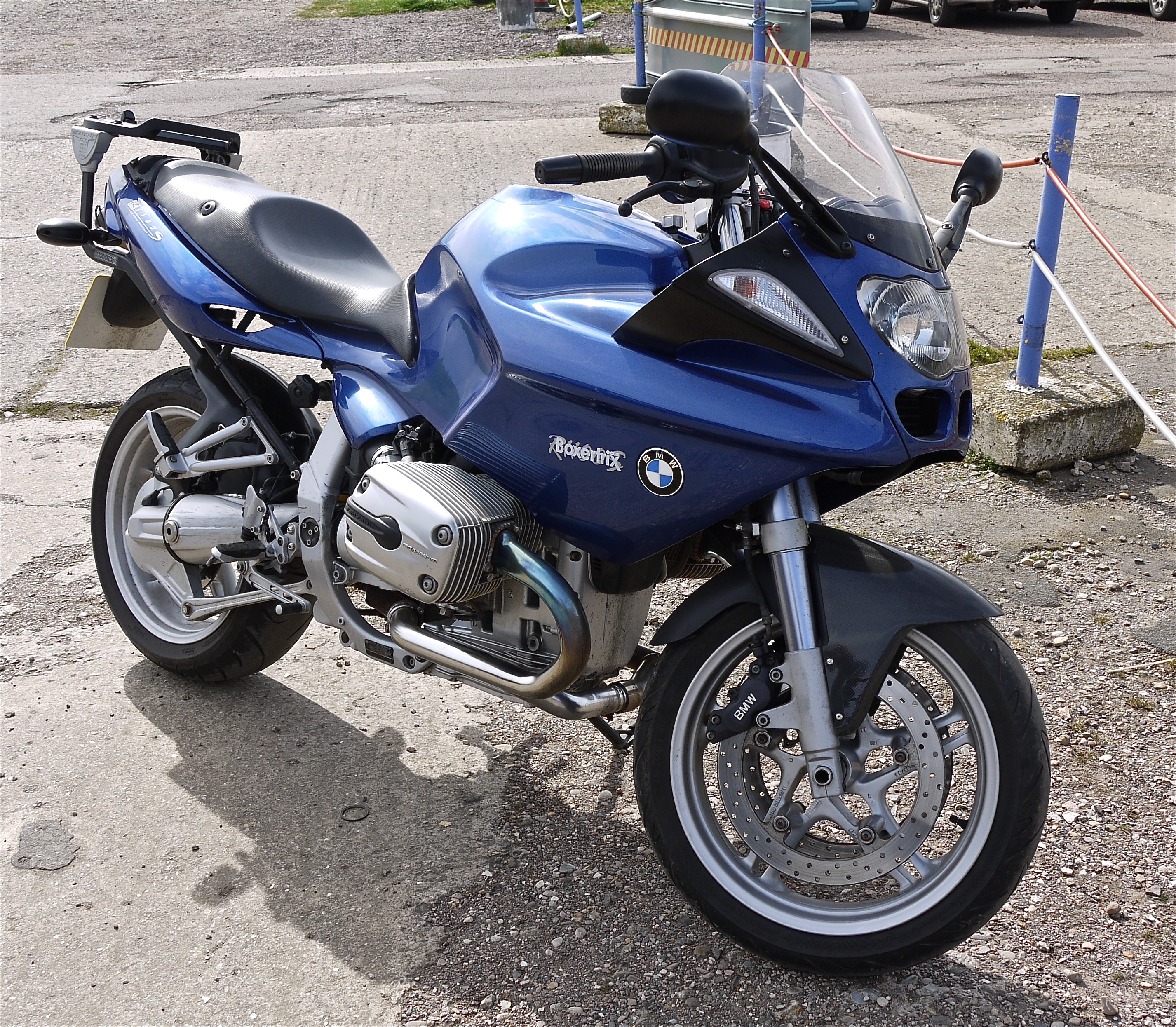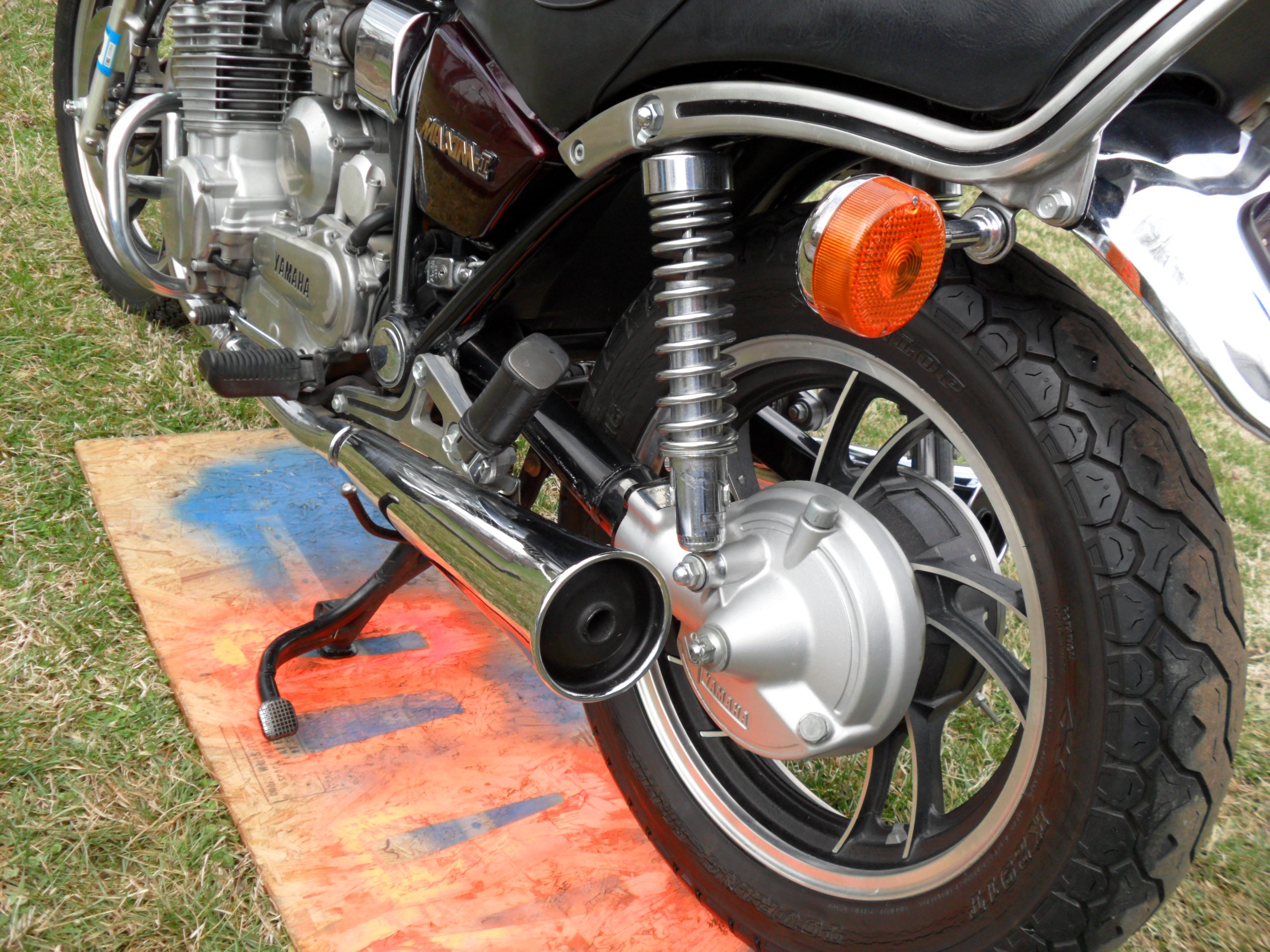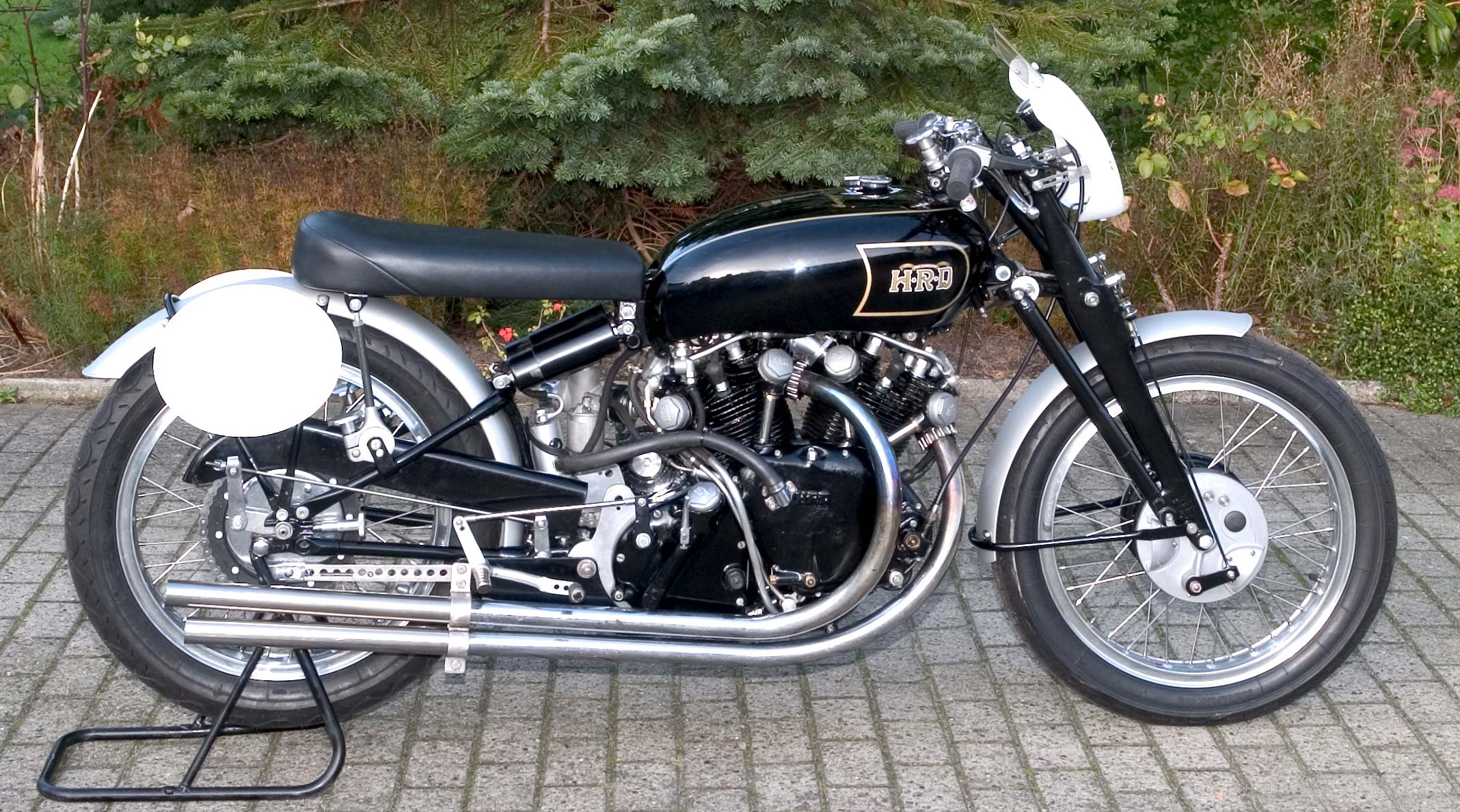|
BMW R1100S
The BMW R1100S is a sports motorcycle that was manufactured by BMW Motorrad between 1998 and 2005. Introduced some 25 years after the R90S, the company's first sports bike, the R1100S was the first BMW bike having clip-on handlebars, rearset footrests and a removable cowl to cover the pillion seat. Producing nearly 100 hp, it has been described as a "sporty sports-tourer". Design The engine is a flat-twin "oilhead" that has air-cooled cylinders but oil-cooled heads. Derived from the BMW R1100RS, the 1,085 cc fuel-injected eight-valve engine is tuned for a maximum output of at 8,400rpm. At the time of its introduction, it was BMW's most powerful boxer engine ever made, and the first mated to a six-speed transmission. The ohv engine has chain-driven camshafts mounted in the cylinder heads, operating the valves via short pushrods and rocker arms. Engines produced after 2003 had dual ignition, with two spark plugs per cylinder. The compact close-ratio six-speed tra ... [...More Info...] [...Related Items...] OR: [Wikipedia] [Google] [Baidu] |
Oil Cooling
Oil cooling is the use of engine oil as a coolant, typically to remove surplus heat from an internal combustion engine. The hot engine transfers heat to the oil which then usually passes through a heat-exchanger, typically a type of radiator known as an oil cooler. The cooled oil flows back into the hot object to cool it continuously. Usage Oil cooling is commonly used to cool high-performance motorcycle engines that are not liquid-cooled. Typically, the cylinder barrel remains air-cooled in the traditional motorcycle fashion, but the cylinder head benefits from additional cooling. As there is already an oil circulation system available for lubrication, this oil is also piped to the cylinder head and used as a liquid coolant. Compared to an oil system used solely for lubrication, oil cooling requires additional oil capacity, a greater flow rate through the oil pump, and an oil cooler (or a larger cooler than normal). If air-cooling proves sufficient for much of the running ti ... [...More Info...] [...Related Items...] OR: [Wikipedia] [Google] [Baidu] |
Ducati 916
The Ducati 916 is a fully faired sport bike made by Ducati from 1994 to 1998. Featuring a fuel injected, 4-valve, desmo, liquid-cooled, 90° V-twin engine in a trellis frame with a single-sided swingarm and USD forks, the 916 is frequently cited as one of the most beautiful motorcycles ever. Design and development The first development of the 916 model family can be traced back to the development of the four-valve Ducati engine, the Desmoquattro, through the development and racing of the earlier Pantah models, to the road-going 851 and 888 models. The chief designer of Ducati motorcycles since the 1970s was Fabio Taglioni (1920–2001), who introduced the Pantah in 1979. The engine was updated in the 1990s in the SuperSport (SS) series and all modern Ducati engines are derivatives of the Pantah, which used its camshafts to both open and close the engine's valves, eliminating the usual valve closing springs, a system called 'desmodromic'. Taglioni, did not, however, have an ... [...More Info...] [...Related Items...] OR: [Wikipedia] [Google] [Baidu] |
Subframe
A subframe is a structural component of a vehicle, such as an automobile or an aircraft, that uses a discrete, separate structure within a larger body-on-frame or unit body to carry certain components, such as the engine, drivetrain, or suspension. The subframe is bolted and/or welded to the vehicle. When bolted, it is sometimes equipped with rubber bushings or springs to dampen vibration. The principal purposes of using a subframe are, to spread high chassis loads over a wide area of relatively thin sheet metal of a monocoque body shell, and to isolate vibrations and harshness from the rest of the body. For example, in an automobile with its powertrain contained in a subframe, forces generated by the engine and transmission can be damped enough that they will not disturb passengers. As a natural development from a car with a full chassis, separate front and rear subframes are used in modern vehicles to reduce the overall weight and cost. In addition a subframe yields benefi ... [...More Info...] [...Related Items...] OR: [Wikipedia] [Google] [Baidu] |
Shaft Drive
A drive shaft, driveshaft, driving shaft, tailshaft (Australian English), propeller shaft (prop shaft), or Cardan shaft (after Girolamo Cardano) is a component for transmitting mechanical power and torque and rotation, usually used to connect other components of a drivetrain that cannot be connected directly because of distance or the need to allow for relative movement between them. As torque carriers, drive shafts are subject to torsion and shear stress, equivalent to the difference between the input torque and the load. They must therefore be strong enough to bear the stress, while avoiding too much additional weight as that would in turn increase their inertia. To allow for variations in the alignment and distance between the driving and driven components, drive shafts frequently incorporate one or more universal joints, jaw couplings, or rag joints, and sometimes a splined joint or prismatic joint. History The term ''driveshaft'' first appeared during the mid-19th centu ... [...More Info...] [...Related Items...] OR: [Wikipedia] [Google] [Baidu] |
Swingarm
A swingarm, or "swinging arm" (UK), originally known as a swing fork or pivoted fork, is a single or double sided mechanical device which attaches the rear wheel of a motorcycle to its body, allowing it to pivot vertically. The main component of the rear suspension of most modern motorbikes and ATVs, it holds the rear axle firmly, while pivoting to absorb bumps and suspension loads induced by the rider, acceleration, and braking. Originally motorcycles had no rear suspension, as their frames were little more than stronger versions of the classic diamond frame of a bicycle. Many types of suspension were tried, including Indian's leaf spring suspended swingarm, and Matchless's cantilevered coiled-spring swingarm. Immediately before and after World War II, the plunger suspension, in which the axle moved up and down two vertical posts, became commonplace. In the latter, the movement in each direction was against coiled springs. Some manufacturers, such as Greeves, used swingarm d ... [...More Info...] [...Related Items...] OR: [Wikipedia] [Google] [Baidu] |
Monoshock
A motorcycle's suspension serves a dual purpose: contributing to the vehicle's handling and braking, and providing safety and comfort by keeping the vehicle's passengers comfortably isolated from road noise, bumps and vibrations. The typical motorcycle has a pair of fork tubes for the front suspension, and a swingarm with one or two shock absorbers for the rear suspension. Front suspension The most common form of front suspension for a modern motorcycle is the telescopic fork. Other fork designs are girder forks, suspended on sprung parallel links (not common since the 1940s) and bottom leading link designs, not common since the 1960s. Some manufacturers (e.g. Greeves) used a version of the swinging arm for front suspension on their motocross designs. A single-sided version of the idea is also used in motor scooters such as the Vespa. The hub-center steering as developed by Ascanio Rodorigo, on a concept associated to Massimo Tamburini is a complex front swingarm alternat ... [...More Info...] [...Related Items...] OR: [Wikipedia] [Google] [Baidu] |
Suspension (motorcycle)
A motorcycle's suspension serves a dual purpose: contributing to the vehicle's handling and braking, and providing safety and comfort by keeping the vehicle's passengers comfortably isolated from road noise, bumps and vibrations. The typical motorcycle has a pair of fork tubes for the front suspension, and a swingarm with one or two shock absorbers for the rear suspension. Front suspension The most common form of front suspension for a modern motorcycle is the telescopic fork. Other fork designs are girder forks, suspended on sprung parallel links (not common since the 1940s) and bottom leading link designs, not common since the 1960s. Some manufacturers (e.g. Greeves) used a version of the swinging arm for front suspension on their motocross designs. A single-sided version of the idea is also used in motor scooters such as the Vespa. The hub-center steering as developed by Ascanio Rodorigo, on a concept associated to Massimo Tamburini is a complex front swingarm alternat ... [...More Info...] [...Related Items...] OR: [Wikipedia] [Google] [Baidu] |
Telescopic Fork
A telescopic fork is a form of motorcycle front suspension whose use is so common that it is virtually universal. The telescopic fork uses fork tubes and sliders which contain the springs and dampers. The main advantages of the telescopic fork are that (i) it is simple in design and relatively cheap to manufacture and assemble; (ii) it is lighter than older designs using external components and linkage systems; and (iii) it has a clean and simple appearance that bikers find attractive. Telescopic forks sometimes have gaiters to protect the fork tubes from abrasion and corrosion. A more modern (and more expensive) version of the conventional telescopic fork is the inverted or "USD" (upside-down) fork. BMW's patented telelever front suspension appears at first glance to be conventional telescopic fork, but the fork tubes contain neither springs nor damping. Instead, a wishbone and an inboard monoshock perform suspension duties, and the forks serve to locate the front wheel an ... [...More Info...] [...Related Items...] OR: [Wikipedia] [Google] [Baidu] |
Patent
A patent is a type of intellectual property that gives its owner the legal right to exclude others from making, using, or selling an invention for a limited period of time in exchange for publishing an enabling disclosure of the invention."A patent is not the grant of a right to make or use or sell. It does not, directly or indirectly, imply any such right. It grants only the right to exclude others. The supposition that a right to make is created by the patent grant is obviously inconsistent with the established distinctions between generic and specific patents, and with the well-known fact that a very considerable portion of the patents granted are in a field covered by a former relatively generic or basic patent, are tributary to such earlier patent, and cannot be practiced unless by license thereunder." – ''Herman v. Youngstown Car Mfg. Co.'', 191 F. 579, 584–85, 112 CCA 185 (6th Cir. 1911) In most countries, patent rights fall under private law and the patent holder mus ... [...More Info...] [...Related Items...] OR: [Wikipedia] [Google] [Baidu] |
Motorcycle Frame
A motorcycle frame is a motorcycle's core structure. It supports the engine, provides a location for the steering and rear suspension, and supports the rider and any passenger or luggage. Also attached to the frame are the fuel tank and battery. At the front of the frame is found the steering head tube that holds the pivoting front fork, while at the rear there is a pivot point for the swingarm suspension motion. Some motorcycles include the engine as a load-bearing stressed member; while some other bikes do not use a single frame, but instead have a front and a rear subframe attached to the engine. Materials In the early days, motorcycles were little more than motorised bicycles, and consequently frames were tubular steel. While the use of steel tubing is still common, in modern times other materials, such as titanium, aluminium, magnesium, and carbon-fibre, along with composites of these materials, are now used. As different motorcycles have varying design parameters (such as ... [...More Info...] [...Related Items...] OR: [Wikipedia] [Google] [Baidu] |
Overhead Valve
An overhead valve (OHV) engine, sometimes called a ''pushrod engine'', is a piston engine whose valves are located in the cylinder head above the combustion chamber. This contrasts with earlier flathead engines, where the valves were located below the combustion chamber in the engine block. Although an overhead camshaft (OHC) engine also has overhead valves, the common usage of the term "overhead valve engine" is limited to engines where the camshaft is located in the engine block. In these traditional OHV engines, the motion of the camshaft is transferred using pushrods (hence the term "pushrod engine") and rocker arms to operate the valves at the top of the engine. Some early intake-over-exhaust engines used a hybrid design combining elements of both side-valves and overhead valves. History Predecessors The first internal combustion engines were based on steam engines and therefore used slide valves. This was the case for the first Otto engine, which was first succ ... [...More Info...] [...Related Items...] OR: [Wikipedia] [Google] [Baidu] |








